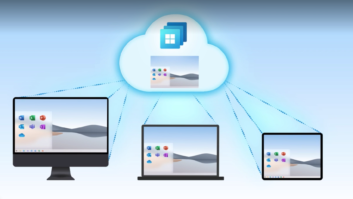
The concept of centralised data storage and software as a remotely hosted and managed service has been around for many years. In the 1990s, large corporations such as IBM, Hewlett-Packard and Microsoft developed the client-server model of computing for business and commercial applications. This architecture moved a large proportion of processing power and capability, along with associated data storage, to centralised mainframe processors and servers.
Connected users would, by means of a low-power ‘thin client’, access that power and data without needing to process it locally. The application, residing and operated on the mainframe computer, was offered to users as Software as a Service (SaaS). This, it was promised, would be the future of computing and would greatly expand the application and reach of programs into the outside world. While this idea did not transform the state of computing overnight, it did slowly become a common mechanism of delivery in some sectors, such as accounting, customer relationship management (CRM) and management information systems. It is still a preferred model in many sectors: CRM alone was an estimated $3.8 billion market in 2011 and is growing every year. More recently, the massive expansion in internet bandwidth, its ease of access, improvements in system security along with a comparable fall in the cost of storage has allowed this technology to become a credible alternative to the standard method of installation and operation of software and content on local machines. It is commonplace in consumer applications such as home banking, iTunes and Facebook. “In early digital signage deployments many operators tended to be a ‘one-stop shop’, doing everything from IT to content creation, media distribution and ad sales,” explains Brian Dusho, CEO of BroadSign International. “It did not take long for them to realise that being in the software or network maintenance business distracted their resources from the core objectives of making money on their media space. Today, digital signage operators are increasingly gravitating towards becoming ‘lean and mean’ media companies rather than being a technology provider. A lot of legacy in-house software products are now being replaced by third-party applications and many look to outsource most of their IT responsibilities, similar to the way TV broadcast networks do it.” Reaping the benefitsFor applications such as digital signage, Cloud technology and SaaS provide significant benefits to operators. “First of all, it reduces capital expenditure as the user has no servers to buy or maintain. It is a more cost-effective solution and requires less IT resource, which only broadens the range of companies that can embrace it,” outlines Howard Smith, founder of Dynamax. “A system like this wouldn’t have been possible 10 years ago. It is particularly useful for companies that start with a few screens and gradually add more. Another major difference between the two methods is the fact that a Cloud-based solution can be deployed over an existing infrastructure, which again opens the door to a whole new range of possibilities. A Cloud-based digital signage system is far less complex so has a more user-friendly interface for organisations without IT support, such as restaurant owners or doctors’ surgeries.”
Scala has offered a Cloud-based mechanism for digital signage for two years and reports a good response from the market; with around 25% of revenues coming from that area. Damon Crowhurst, senior director, EMEA, says: “We expected the Cloud service to be attractive mainly to small companies operating a few screens that didn’t want to invest in their server or have an in-house IT capability. However it is also being taken up by larger organisations, such as Jaguar-Land Rover, with over 1,600 screens. These companies welcome the speed of deployment and the opportunity to outsource all services as well as its global reach and lower overall costs. Cloud-based systems are used more effectively than in-house ones and companies are likely to use a greater range of services and develop new applications.” Everything, everywhereAnother significant factor that has driven the market has been the necessity to deliver all content to all devices. “Everyday devices like phones, TVs and PCs are more connected and more capable than ever before,” says David Webster, CTO, RGB Communications. “With computing technology becoming unobtrusive and embedded in all our digital devices and capable of communicating wherever we are, applications are starting to go beyond simple calls, messaging and content consumption to a more intelligent way of interaction with human beings. The key component is Cloud technology: a combination of personal content stored in the Cloud, real-time data, such as the presence and actions of people, and event-driven intelligent software will start to provide complex tasks and control in either automatic or simple and intuitive ways.”
However, this technology is not without its pitfalls. Security is still a concern to most organisations and complicated measures must be put into place to accommodate it. Another concern is the way that uncontrolled data exchanges can swamp and occasionally limit networks; in retail installations, tills and stock control systems cannot be allowed to fail, and in other sectors a slowing of services such as data, voice and videoconferencing can adversely affect business operation. Both can be overcome through the deployment of parallel networks, although this can prove costly.
A word of warning from Colin Farquhar, CEO of Exterity: “While the benefits of Cloud technology will no doubt come to light in the long term, the practical realities of installation, infrastructure and the control required potentially make Cloud systems more difficult to deploy than traditional systems. However, the biggest challenge with using Cloud technology is bandwidth. The Cloud requires bandwidth to deliver content and the more content being delivered, the more bandwidth is needed. Many organisations will find the demands of bandwidth for this application don’t match the actual business demands. Until these fundamentals are overcome the full benefits of the Cloud will not be fully realised.”
The Cloud is particularly useful for the distribution of live video, particularly large-scale stadium installations where otherwise a full on-site broadcast suite would be required. “Rather than installing and operating an expensive studio on site, which may only be utilised perhaps 30 days a year, a club can use ADI’s ‘studio in a Cloud’, as and when required,” ADI CEO Geraint Williams explains.
“Live Venue takes advantage of the latest wave of communication technology available to the market: dedicated high-speed fibre optic links enable ADI to receive live match coverage from the stadium, mix it with other content and send it back to the stadium screens in real time, with no latency. This brings cost savings in a number of areas, including equipment, training and staffing, and ensures a future-proof solution, as the equipment never goes out of date. We can manage every screen in the stadium, from the giant LED screens, perimeter advertising and scoreboards to the hundreds of LCD panels in hospitality and concourse areas, and all featuring bespoke, multi-zoned programming. Live Venue also has applications beyond the stadium, by acting as a global distribution studio. We utilise the latest streaming technologies and hardware to allow netcasting to multiple devices and can broadcast bespoke programming live to global territories thanks to our direct links to BT Tower.”
Videoconferencing is another audiovisual application that is benefitting greatly from Cloud technology. Two new products offered to this sector by distributor Imago show considerable ranges of new features, as Peter Nice, head of new business at Imago Group, explains: “Videoconferencing is becoming more proprietary as IT manufacturers and new technologies appear in the market. VideoMeet from Deutsche Telekom uses the Cloud to connect various communication devices while eliminating operating complications. It is a unique system that bridges all types of disparate devices into a single videoconferencing system: traditional videoconferencing systems including PC, Mac, smartphone, tablets, Skype, Microsoft Lync, Google video chat or standard telephones. This allows office, home and mobile workers to communicate whatever system they use.
“Another system, Watchitoo, is unique in that no bespoke software is required to participate or view a meeting or event as the content is played using a standard Flash Player. It allows up to 25 synchronous HD video feeds to interact and participate while many more can view online. The newest release now allows users of handheld devices and iPads to view events and meetings. Product features include extensive production facilities to manage contributors, preparing and checking their video and audio settings before going online and laying out multiple feeds on styled display templates. So it is ideal for corporate meetings and launches, live events, education and training applications and can even be used as a broadcast channel with audience participation. One of the most powerful features of Watchitoo is the ability to embed the service into a website so that a content provider or broadcaster can maintain their corporate branding.” Encouraging interactionOne aspect of technology that is becoming more pertinent and available is interactivity, as users, particularly younger ones, expect and demand instant interaction and response, again on any device. Teodros Gessesse, product manager at VBrick, says: “This entire market is moving so fast that it is impossible to predict what is likely to appear beyond a few months, although without doubt, interactivity and video communication is becoming ‘the norm’, right across the business spectrum from sales, through training to corporate briefing sessions. The key aspect of all video-based communication systems today is interoperability. We concentrate on creating tools that enable this and are adaptable to the underlying conditions; whether that is bandwidth or user-related. These are based on non-proprietary, general standards that effectively hide the underlying complexity, but are still totally secure, so that users don’t have to understand manage and configure their devices, it is all done for them automatically.”
Stardraw uses the Cloud in the operation of its systems, as David Snipp, CEO, explains: “When products are deployed, particularly within audiovisual and control systems, users demand access to them remotely, so that they can manage their lifestyle from a distance using any device. We have found that the only effective way to do this is to use the Cloud as a communication channel with its inherent security and encryption to keep it safe. This is a far more effective and secure solution than the alternatives of opening ports in firewalls or installing VPNs.”
What’s next? Systems that provide intelligence and a higher-level integration of AV, lighting, HVAC, communications and other AV subsystems will be next to become Cloud based. This will mean a more software-based approach to systems integration, focused on simplified user interfaces as the underlying systems become more complex.We are, however, still only in the initial stage of adoption. SaaS allows upgrades to be implemented quickly across the user estate; a single copy of software managed by the vendor and accessed by multiple users simultaneously means that they all receive the update together, without the expense and technicalities of individual upgrades.
Webster predicts: “Potentially the market for this new internet-of-things is vast. Integrators are well positioned to provide new features which add another level of interaction between humans and their environment, offering new ambient intelligence software capabilities that will help drive transformation in the AV industry. Perhaps the biggest stumbling block for integrators is the investment needed to learn, embrace and sell the necessary network and software services that may well become vital for their future, in order to offer solutions which enrich their customers’ lives.” www.adi.tvwww.broadsign.comwww.digitalsignage.netwww.exterity.comwww.imagogroupplc.comwww.lifesize.comwww.rgbcomms.comwww.scala.comwww.stardraw.comwww.vbrick.com







